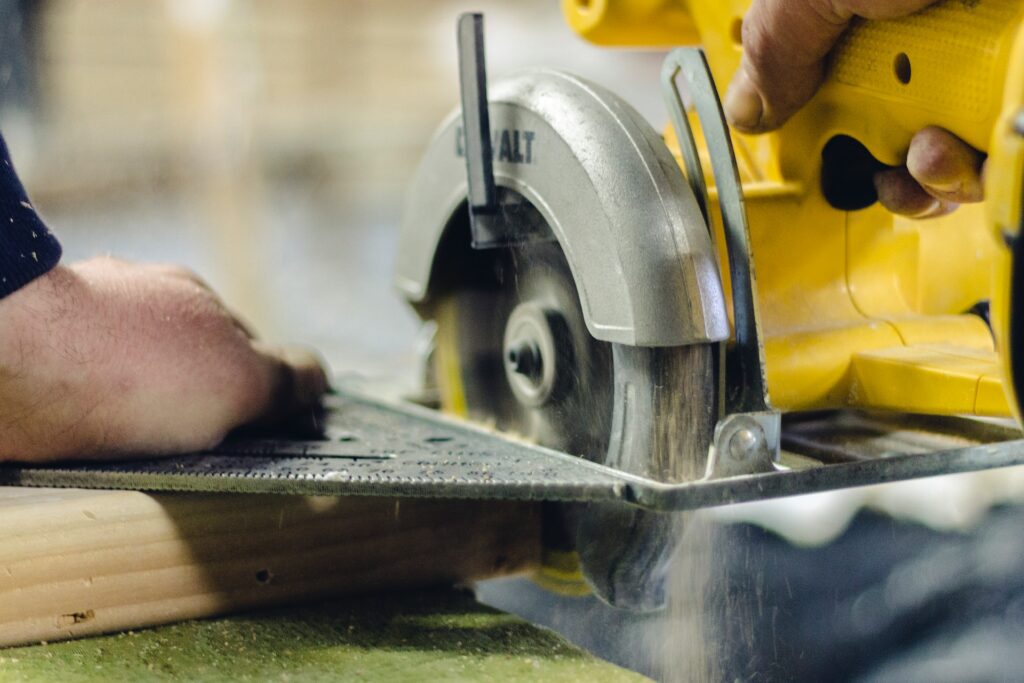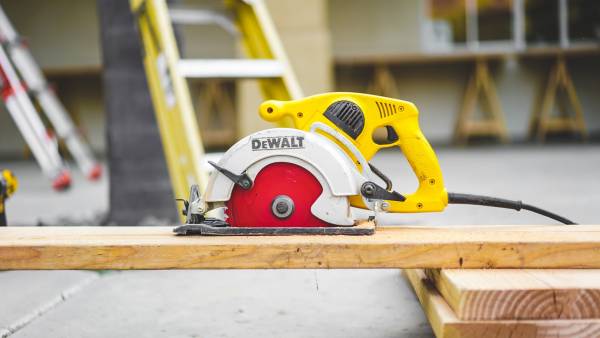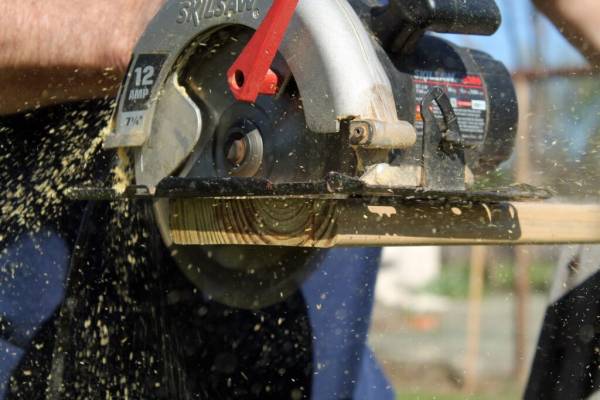When exploring the hardware stores, choosing in corded vs. cordless circular saw can be tricky.
To select the ideal model for your needs and complete the task at hand, you must know which of these circular saw models would be the best for you.
Both saws can do the task despite each having advantages and disadvantages. We’ll offer you a quick overview of the differences between a corded and cordless circular saw in this article and advice on determining which one is best for you.
Cordless circular saws are worthwhile in various ways.
Cordless is wonderful if you’re on the go and don’t need to make many cuts.
But, if you need to work with complex, woody materials for an extended period and have access to power, a cordless circular saw is not the best option.
This article is made to remove your confusion when deciding to choose in corded vs. cordless circular saw.

Corded vs. Cordless Circular Saw | The Corded Circular Saws!
The corded circular saw is the traditional circular saw.
- It is typically used to cut wood, but you can also use them to cut other materials like plastic with a simple blade adjustment.
- A power cord and an outlet are required for a corded circular saw to function and can deliver greater power than a cordless version.
- It is possible to set up a corded circular saw as a left- or right-handed saw.
- Due to this saw’s power, the corded circular saw can cut through rigid materials, making it a heavy-duty model for any operation.
- Many corded circular saws are powerful and relatively light, weighing anything from 7 to 12 lbs on average.
- The corded circular saw has additional features that improve accuracy and performance; the blade and the motor.
- Impressive cut depths and angle stops can be found in most corded circular models on the market.
The performance of corded circular saws sets them apart because they can be used in even the most demanding tasks.
Below are some features of Corded circular saws to consider.
Blades
The blade’s ability of a Corded circular saw to cut is greatly influenced by its substance.
The sort of teeth blades you choose depends on the material you’ll be working with and ranges in size from 32 to 80.
Always use the correct blade size and number of teeth to achieve optimum performance and exact cuts.
Related article: How to Tighten Circular Saw Blade? | A Step-By-Step Guide!
Price
This equipment is adjustable and durable, so it should last many years. It is also regarded as the saw with the most affordable price range available.
Safety Precautions
When cutting, you must always ensure that the circular saw’s power cable is kept out of the way.
Due to the potential for cutting the cord, corded circular saws are a little riskier than cordless ones.
When the saw is running, the blade cover keeps your hands away from the blade.
If you have a lot of heavy labor to accomplish, a circular saw that plugs into a wall outlet would start to show its actual value. They can continue to cut for hours at the same power level, but the length of the cable limits it.

Corded vs. Cordless Circular Saw | The Cordless Circular Saw!
The cordless saw has only lately begun to be produced compared to their corded counterparts.
A cordless circular saw will do all the same tasks as a corded circular saw but runs on battery power rather than electrical power.
The cordless circular saw is portable because it is battery-powered. But, your battery can run out of power very rapidly if you try to cut through a challenging piece of wood.
It’s essential to keep in mind that both corded and cordless circular saws have similar parts, such as a motor and blade, as well as extra features like bevel stops, dust blowers, and lasers for precise cutting.
You may also change the cordless circular saw’s height, depth, and slant to achieve your desired cut.
The battery, however, is the part of the cordless saw that stands out the most.
The cordless saw’s power is the only potential problem. Any battery-powered tool will not have the same power as an electric-powered one. Your battery can run out of power very rapidly if you are trying to cut through a challenging piece of wood.
Powerful motors, many of which are brushless, are a feature of cordless circular saws, enabling them to run continuously for a long time.
Some cordless machines have RPMs of up to 5,200; some are exceptionally light, with the thinnest model weighing just 6.8 lbs.
Below are some features of Cordless circular saws to consider.
Blades
There is a considerable selection of blades available for cordless circular saws, like for corded ones.
However, if you choose larger blades, ensure that the blade size is just 6.5 inches, so you should match your blade to the material you are cutting.
Price
In general, cordless circular saws tend to cost slightly more than their corded counterparts.
To ensure that your saw runs for extended durations, you will need to purchase a battery and maybe a backup battery, which is why the price rises.
Safety Precautions
Circular saws without cords may be a little bit safer than corded models.
The possibility of cutting a chord when using a cordless saw is eliminated, which is a significant safety factor.

Final Comparison: Corded vs. Cordless Circular Saw!
When it comes to corded vs. cordless circular saws, there is no right or wrong; they are simply different.
You can use the recommendations in this article to choose the best circular saw by carefully evaluating how frequently and for what purpose you will use it.
Which Saw Suits Your Needs Best?
Below are the different scenarios according to which you can choose a corded vs. cordless circular saw.
For Portability: Cordless Circular Saw
The cordless saw will be your greatest option if you require something you can utilize smoothly as you go from one spot to another.
The cordless version will be far more practical and effective if you work in an area with limited power outlets, where you would need numerous extension cords to make the corded version function well.
For Power: Corded Circular Saw
Models with cords have unlimited battery life but depend on a power source and outlets to function.
We advise keeping the engines in good condition to ensure durability because periodic maintenance of the tool frequently causes anomalies in the durability of the corded ones.
Above all, you will need the corded model if you intend to use your circular saw continuously throughout the day without stopping and recharging your equipment.
For Cost: Corded Circular Saw
Make sure you consider that you will probably need to buy a battery or numerous batteries to operate a cordless saw when you are considering buying a circular one.
For Weight: Corded Circular Saw
Although corded saws are significantly larger, cordless saws are heavier.
Choosing cordless equipment is the best option if you’re using your saw in places with no power outlets or if the place is far from outlets.
However, keep in mind that considering the weight, using it will be difficult.
Instead, you can use various extension cords to prevent arm fatigue, especially if you use them all day. Professional users favor cordless equipment more, and we advise avoiding unnecessary fatigue that can lengthen your working days.
For Versatility: Corded Circular Saw
The adaptability of the corded and cordless versions varies the greatest. The ability to cut wood accurately, even with an older saw, is the primary benefit of corded circular saws.
Additionally, it is lighter, making DIY projects simpler without worrying about uneven cuts.
Why Can Only Left-Handers Use Some Cordless Circular Saws?
A cordless circular saw is typically positioned on the left side because it is designed to cut straight lines and make the most of its orientation.
- The key benefit of the cordless variant is that it evenly distributes the saw’s weight across the material, improving cutting stability and precision.
- Additionally, since it’s less likely to backfire, it enables a safer approach.
- Since the engine won’t obstruct the vision when working, the woodworker can receive a more precise view using left-handed circular saws.
- Additionally, because the cord is positioned on the left side, corded saws are frequently right-handed.
With that said, let’s move toward the conclusion.
Conclusion
Both corded and cordless circular saws work admirably well when cutting, so your decision will only be influenced by your personal preferences.
In our comparison of corded vs. cordless circular saws, we found that the latter had more mobility features. However, a corded version of the saw also won’t let you down if you believe you can use outlets every time you use it.
If you found value in this article, share it with your gardener friends.
Also, let us know about anything you have to say in the comments below.
Lastly, thanks for reading!
